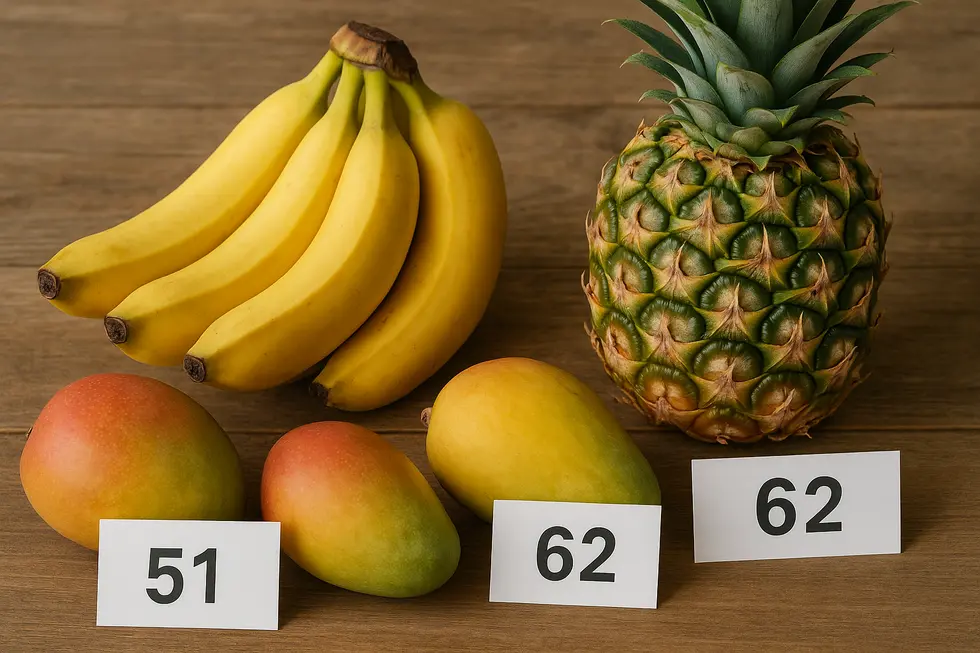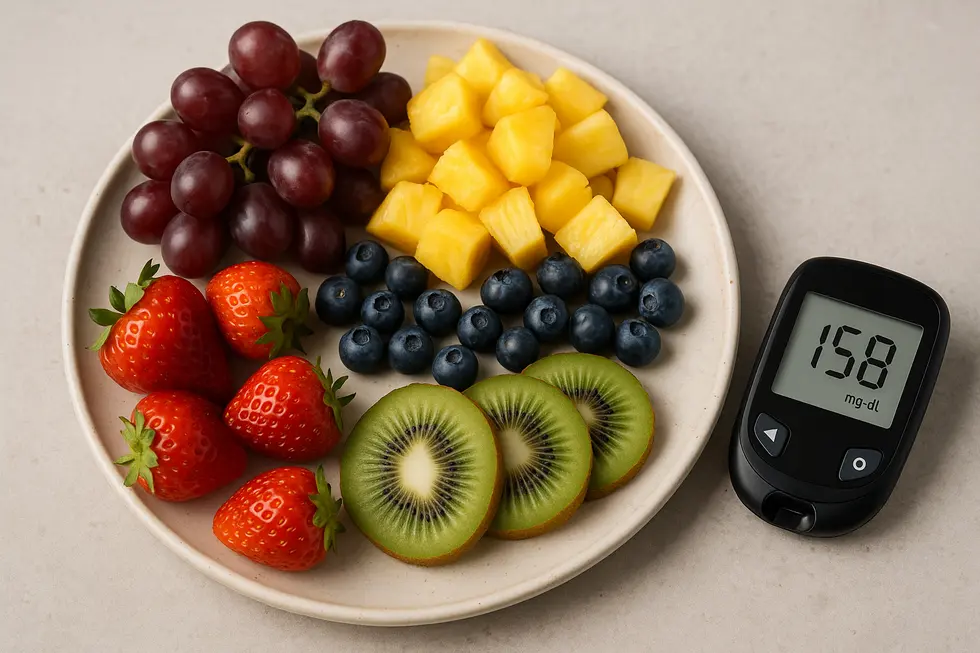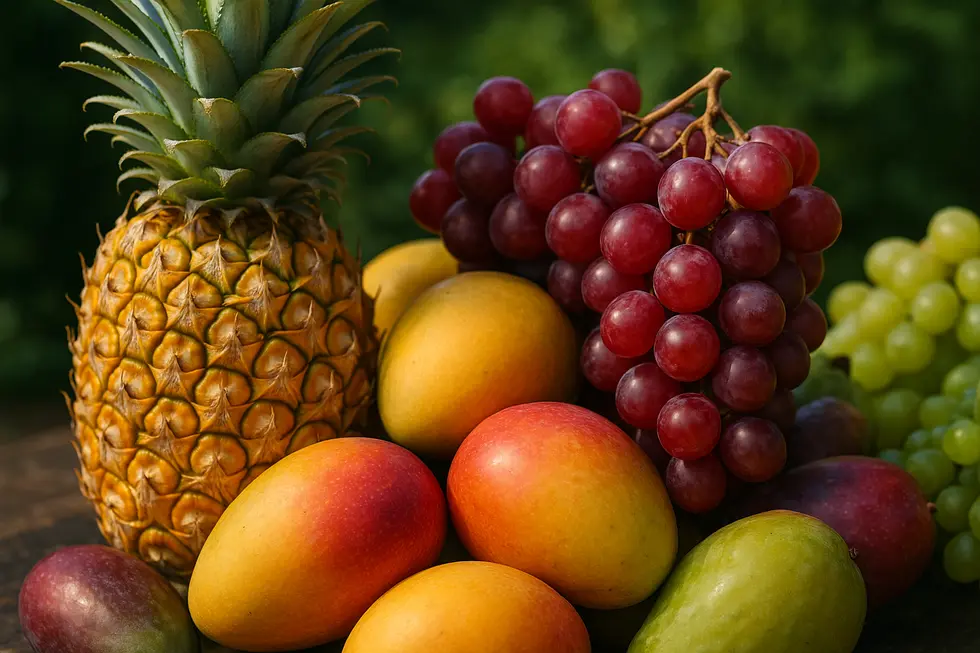High glycemic fruits, while delicious and nutrient-rich, can cause significant spikes in blood sugar levels due to their glycemic index (GI). For diabetic individuals and health-conscious people keen on managing their glucose levels, understanding these fruits is crucial. This article explores the GI of high glycemic fruits, sheds light on their health impacts, and guides on nutritional considerations for including them in your diet.
Decoding the Glycemic Secrets of High Glycemic Fruits

Understanding the Glycemic Index: A Crucial Metric
To truly comprehend the impact of high glycemic fruits on our health, it’s essential to delve into the concept of the glycemic index (GI). The GI ranks carbohydrate-containing foods based on their effect on blood glucose levels, assigning pure glucose a benchmark value of 100. Foods with a high GI cause rapid rises in blood sugar, often leading to quick spikes that those with diabetes or anyone striving to stabilize their energy levels should manage carefully.
High glycemic fruits, typically with a GI of 70 or above, are essential to identify for individuals aiming to keep their glucose metrics in check. Watermelon and pineapple are two classic examples, though their precise GI values can fluctuate based on factors like ripeness and preparation methods. Understanding these details helps make more informed dietary choices, promoting better overall health and metabolic stability.
Balancing Act: Glycemic Index versus Glycemic Load
While the GI provides insights into how rapidly a food might increase blood sugar levels, it doesn’t offer the complete picture when considered in isolation. This is where the glycemic load (GL) comes into play. GL incorporates both the GI and the quantity of carbohydrates in a typical serving size, thus offering a more comprehensive view of how a particular fruit might affect one’s glucose levels.
For instance, some fruits may possess a high GI but yield a low GL when consumed in moderate amounts. This understanding moderates their overall impact on blood glucose. Recognizing this balance is crucial for managing dietary intake and ensuring that even high-glycemic fruits can be consumed in a nutritionally beneficial manner.
Strategic Fruit Choices for Optimal Health
Making informed choices about fruit consumption is particularly vital for individuals with diabetes or those conscious of their blood sugar levels. Opting for fruits with a lower GI can prevent drastic fluctuations in energy levels, maintaining a steady state that is essential for daily activities and overall well-being.
Low-GI fruits, which include options like grapefruit, strawberries, cherries, raspberries, peaches, grapes (both red and green), oranges, apples, and plums, are scientifically shown to produce more stable glucose responses, as evidenced in real-world continuous glucose monitoring studies. Integrating these fruits into one’s diet not only provides a satisfying taste experience but also supports metabolic balance.
Nevertheless, the consumption of high-GI fruits requires a strategic approach. Portion control becomes indispensable, and pairing these fruits with other low-GI foods can help counteract potential rapid increases in blood glucose. Such combinations allow individuals to enjoy the nutritional and flavorful benefits of these fruits without compromising their metabolic goals.
Harnessing Online Resources for Fruit GI Values
For anyone aiming to further personalize their dietary choices, especially regarding fruit selections, consulting comprehensive databases like GlycemicIndex.com can be illuminating. These platforms provide updated information on GI values, serving sizes, and evidence from tested studies, empowering users to tailor their fruit consumption according to their unique health needs.
As we continue to explore the complex interplay between diet and health, understanding the role fruits play in affecting our glycemic response becomes increasingly relevant. Whether navigating the landscape of dietary choices for diabetes management or simply striving to maintain balanced energy levels, appreciating the nuances of high glycemic fruits equips us with the knowledge necessary to make decisions that align with our health goals.
For more insights into managing blood sugar and incorporating these principles into daily life, consider exploring resources on glycemic index management and dietary strategies.
Navigating the Health Impacts of High Glycemic Fruits

Consuming high glycemic fruits can have a pronounced impact on health, particularly for individuals managing diabetes or those vigilant about maintaining consistent blood sugar levels. The Glycemic Index (GI) serves as a valuable tool in measuring how swiftly different foods, including fruits, affect blood sugar. High Glycemic Index foods such as grapes, mangoes, bananas, and pineapples, characteristically cause rapid glucose surges, which pose challenges for blood sugar management.
While these fruits might be less ideal for those with diabetes, they are not devoid of nutritional benefits. For instance, mangoes are laden with vitamins and antioxidants, while bananas offer significant potassium. Despite their health benefits, the high sugar content in these fruits, particularly glucose and fructose in grapes, demands careful consideration and moderation in their consumption to avoid adverse health impacts.
The immediate effects of consuming these high GI fruits are often witnessed in the form of abrupt spikes in blood glucose levels, which can lead to unexpected energy crashes and mood fluctuations. This rollercoaster effect, over time, can bestow more severe consequences, such as fostering insulin resistance—a precursor to type 2 diabetes—and contributing to weight gain. Managing energy levels and mood becomes increasingly challenging when the diet heavily features high glycemic fruits without balancing elements.
However, it is essential to recognize that not all fruits rank high on the Glycemic Index. Many fruits such as raspberries and peaches are considered low to moderate GI foods and are abundant in dietary fiber. This fiber content plays a pivotal role in slowing digestion and absorption, thereby mitigating drastic blood sugar fluctuations.
To manage the impacts of high glycemic fruits, consider integrating them into meals thoughtfully. Combining these fruits with foods rich in fiber and protein can significantly temper the swift release of sugars into the bloodstream. This strategy involves making choices such as adding nuts or seeds to a fruit salad or pairing bananas with yogurt. Fiber and protein help extend digestion, leading to slower, more manageable rises in blood glucose.
Further, as a guiding principle, opt for whole fruits over fruit juices or processed versions. Whole fruits contain naturally occurring fibers that juices lack, providing an intrinsic mechanism to moderate sugar absorption. Processed fruits often have added sugars that can exacerbate their impact on glucose levels, rendering them less ideal in comparison to their whole counterparts.
Understanding and applying these considerations in daily dietary choices is invaluable, particularly for those managing diabetes or pre-diabetes. By being mindful of the GI score of fruits and their consumption context, one can maintain better control over blood sugar levels while continuing to benefit from the vital nutrients that these fruits offer.
For a deeper insight into managing diabetes with dietary choices emphasizing the Glycemic Index, exploring resources such as the Glycemic Index Guide on Diabetes Management can be beneficial. These resources provide comprehensive insights into incorporating low glycemic foods effectively into one’s diet, further aiding in blood sugar management.
Balancing Nutrition and Blood Sugar: Navigating High Glycemic Fruits
High glycemic fruits often spark discussions about their suitability for individuals mindful of blood sugar levels, yet they hold significant nutritional value that merits deliberate inclusion in diets. These fruits, like mangoes, bananas, and pineapples, are characterized by their rapid effect on blood glucose due to their elevated glycemic index (GI). The GI measures how quickly carbohydrates in foods raise blood sugar levels, with numbers over 55 generally considered high. While indiscriminate consumption can lead to sharp blood sugar spikes, understanding the nutritional profile of these fruits provides a pathway for thoughtful dietary choices.
High glycemic fruits are not devoid of merit. They are abundant in essential vitamins and antioxidants that support overall health. Mangoes, for instance, are rich in vitamin C and beta-carotene, substances known for their immune-boosting and antioxidant properties, respectively. Bananas offer a significant source of potassium, which is vital in maintaining heart health, while pineapples provide unique enzymes like bromelain, known for aiding digestion and potentially reducing inflammation. Grapes, although less impactful by their moderate GI, are similarly packed with beneficial compounds. These fruits, despite their GI, can contribute positively when consumed mindfully.
For individuals managing diabetes or those at risk, the crux lies in moderation and combination with other foods. Integrating high glycemic fruits with low-GI foods can mitigate blood sugar spikes. Pairing these fruits with sources of protein and fiber—such as nuts or legumes—slows sugar absorption, reducing the risk of sudden blood sugar increases. Additionally, opting for whole fruits over processed juices is crucial because they maintain the fibrous skin and natural pulp, which aid in moderating glucose release. Portion control plays an equally pivotal role, where even small quantities can permit enjoying the benefits without adverse impacts.
Mindful consumption extends beyond mere combination to the context of the entire diet. A balanced diet is paramount. High glycemic fruits can be part of a healthful eating pattern if integrated into meals rich in low-GI foods. Incorporating more fruits with lower glycemic indices, like apples and berries, alongside these higher-GI options maintains enjoyment without jeopardizing health. The key is to create meals around low glycemic index vegetables, grains, and protein sources, stabilizing post-meal glucose levels, and ensuring nutrient diversity.
Another avenue to manage intake effectively is becoming more acquainted with the glycemic index itself. By understanding the spectrum of glycemic values, one can make more informed decisions. Resources such as the Glycemic Index Guide offer valuable insights into varying foods’ indices, serving as a reference for shaping diets. This knowledge equips individuals with the ability to tailor their dietary choices to both enjoy high glycemic fruits and manage their health commitments effectively.
The discourse surrounding high glycemic fruits is nuanced, combining scientific understanding of blood sugar with the broader context of nutritional benefits they offer. While these fruits should be consumed thoughtfully, they do not necessitate exclusion. By emphasizing balance, portion management, and combinations with low-GI foods, individuals can leverage the health benefits without compromising blood sugar management. This harmonized approach ensures that the enjoyment of nutritious high glycemic fruits can complement a well-rounded, health-conscious lifestyle.
Final thoughts
High glycemic fruits can be part of a nutritious diet even for those needing to manage blood sugar levels, when savvy choices are made. Understanding the GI, recognizing health impacts, and carefully considering nutritional aspects enable individuals to enjoy these fruits without compromising their health goals.
Don’t just read about better health—live it. Download the Glycemic Index Guide Tracker today to start making smarter food choices, track your glucose, and stay on top of your nutrition—all in one app.
About us
Glycemic Index Guide Tracker is a powerful yet easy-to-use mobile app designed to help you make informed dietary choices by tracking the glycemic index (GI) and glycemic load (GL) of the foods you eat. Whether you’re managing diabetes, following a low-carb or keto diet, or simply aiming to maintain steady energy and better health, the app offers a comprehensive food database, nutrition and glucose tracking tools, weight monitoring, and curated low-GI recipes—all in one intuitive interface. It’s your go-to companion for understanding how different foods affect your blood sugar and for building smarter eating habits.


Leave a Reply